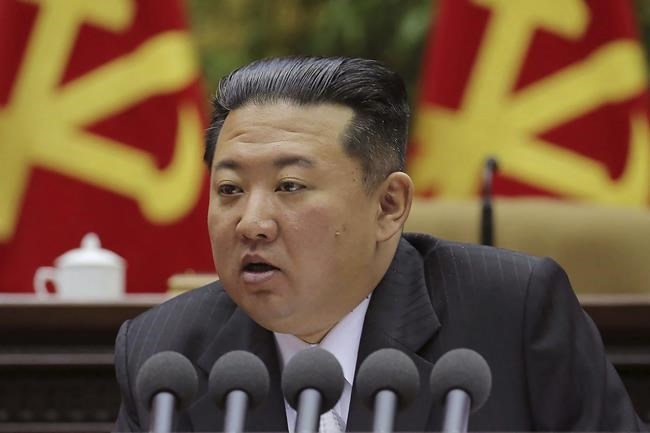SEOUL, South Korea (AP) — A North Korean missile fired from its capital region exploded in mid-air in an apparent failed launch on Wednesday, South Korea’s military said, amid speculation that the North could soon launch its biggest long-range missile in its most significant provocation in years.
Details of the missile explosion weren't immediately known. But the launch, the 10th of its kind this year, shows North Korea is determined to press ahead on its push to modernize its weapons arsenal and pressure its rivals into making concessions amid dormant denuclearization talks.
The North Korean missile blew up while it was flying at an altitude of about 20 kilometers (12.4 miles), a South Korean military official said requesting anonymity because he wasn't publicly authorized to speak to media on the issue. He said the cause of the explosion wasn't known.
South Korea’s Joint Chiefs of Staff earlier said in a statement that the launch made from the Pyongyang region around 9:30 a.m. apparently failed. It said South Korean and U.S. intelligence authorities were analyzing details of the launch.
The U.S. Indo-Pacific Command later said that North Korea fired a ballistic missile but didn’t say whether it was a failed launch. A command statement said the launch didn’t pose an immediate threat to U.S. territory and its allies but called on North Korea to refrain from further destabilizing acts.
Japanese Chief Cabinet Secretary Hirokazu Matsuno told reporters that a flight of a ballistic missile has not been confirmed and that Tokyo is working with Washington and Seoul to further analyze what happened.
Experts say past failures still have moved North Korea closer to its goal of acquiring a viable nuclear arsenal that could threaten the American homeland. Of eight “Musudan” intermediate-range missiles tests in 2016, only one of those launches was seen by outside analysts as successful, which led to debates of whether North Korea’s path toward ICBMs had been cut off.
However, the North in 2017 flew more powerful intermediate-range missiles over Japan and conducted three successful test-flights of ICBMs that demonstrated a potential range to strike deep into the U.S. mainland.
North Korea’s successful satellite launches in 2012 and 2016 — which were viewed by the U.N. as disguised tests of its long-range missile technology — also followed repeated failures.
The U.S. and South Korean militaries said last week that North Korea had tested an ICBM system in two recent launches, referring to the developmental Hwasong-17 missile that North Korea unveiled during a military parade in October 2020.
In the two recent launches on Feb. 27 and March 5, the North Korean missiles flew medium-range distances, and experts have said North Korea could eventually perform a full-range ICBM test.
The North has said it tested cameras and other systems for a spy satellite and released what it said were photos taken from space during one of the two tests, but it didn’t confirm what rocket or missile it launched.
Observers say North Korea aims to boost its ICBM capability while trying to place its first functioning spy satellite into orbit. North Korean leader Kim Jong Un has vowed to acquire an improved ICBM and a spy satellite among an array of sophisticated weapons systems he says his country needs to cope with what he calls American hostility.
The Hwasong-17 is North Korea’s biggest missile, which could potentially fly up to 15,000 kilometers (9,320 miles), far enough to strike anywhere in the U.S. and beyond. The 25-meter (82-foot) missile, which was shown again at a defense exhibition in Pyongyang last year, has yet to be test-launched.
The three ICBMs that North Korea tested in 2017 were the Hwasong-14 and Hwasong-15. Some analysts say developing a larger missile could mean the country is trying to arm its long-range weapons with multiple warheads to overcome missile defense systems.
If North Korea makes a new ICBM launch, it would be its highest-profile weapons tests since its third and last ICBM launch in November 2017.
North Korea will likely call its potential new ICBM test a rocket launch to place a reconnaissance satellite in space, not a weapons test. That could invite condemnation but likely no fresh U.N. sanctions, some analysts say, since Russia and China wield vetoes on the Security Council and would oppose it.
Other North Korean missiles tested this year were mostly shorter-range, nuclear-capable weapons which place South Korea and Japan, both key U.S. allies, within striking distance. In January alone, North Korea carried out seven rounds of missile tests, a record number of monthly tests since Kim took power in late 2011.
U.S.-led diplomacy aimed at persuading North Korea to abandon its nuclear program collapsed in 2019 due to wrangling over U.S.-led sanctions on the North. Washington has urged North Korea to return to talks without any preconditions, but Pyongyang has rejected such overtures saying the United States must first withdraw its hostile policies.
In January, North Korea hinted at lifting its 4-year moratorium on ICBM and nuclear tests. South Korea’s Defense Ministry said Friday it detected signs that North Korea likely is restoring some of the tunnels at its nuclear testing site that it detonated ahead of the now-dormant nuclear diplomacy.
The U.S. Treasury Department last week announced new sanctions against three Russian-based entities that aided ongoing development of North Korea’s military capabilities and two individuals tied to those companies. The sanctions block access to any U.S. assets held by them.
__
Associated Press writer Mari Yamaguchi in Tokyo contributed to this report.
Hyung-jin Kim And Kim Tong-hyung, The Associated Press



